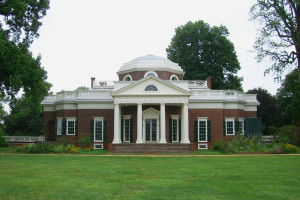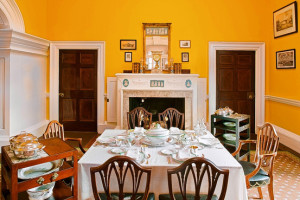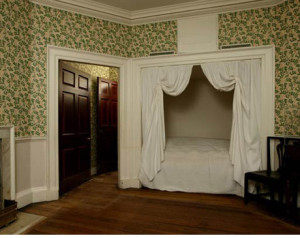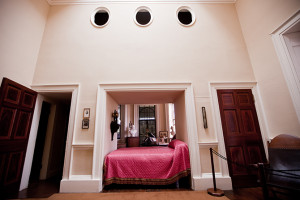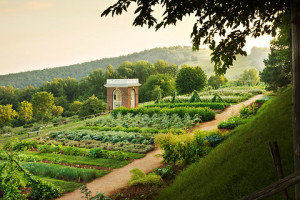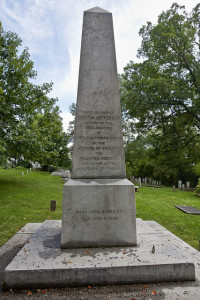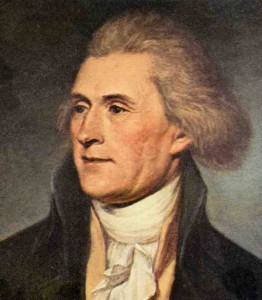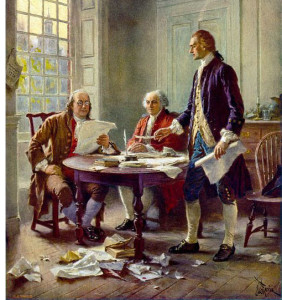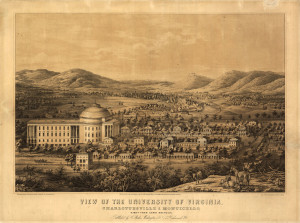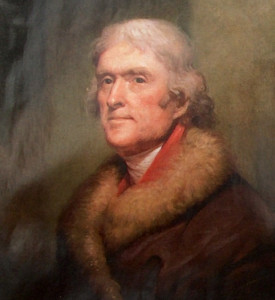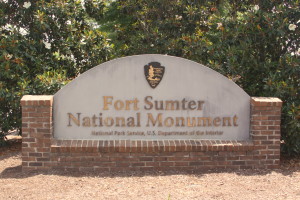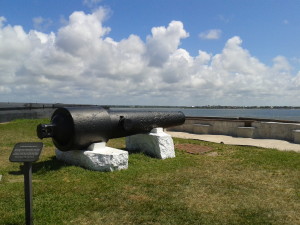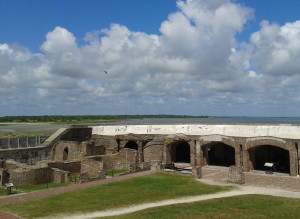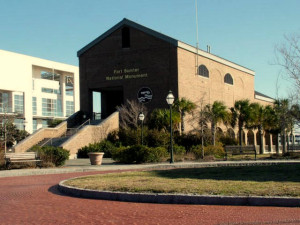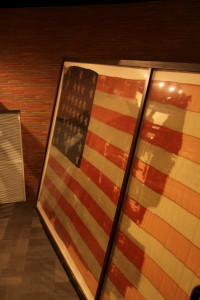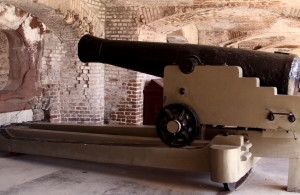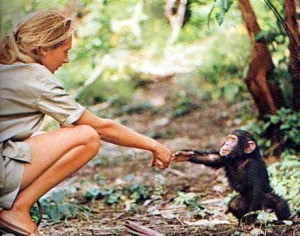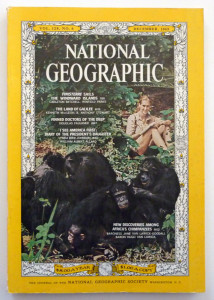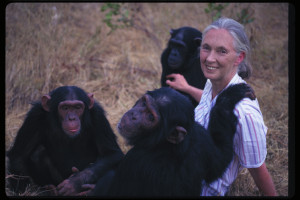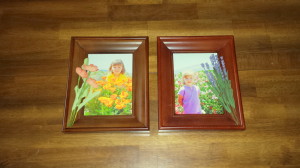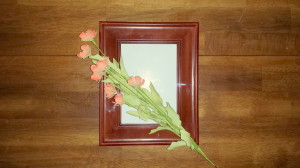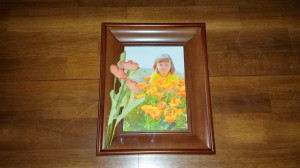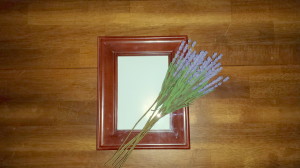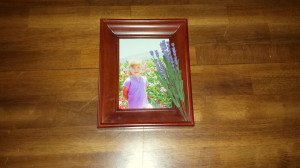During our family vacations around the country over the years we have been able to visit many historic homes of our past U.S. Presidents, such as George Washington’s Mt. Vernon, James Monroe’s Montpelier, and Abraham Lincoln’s home in Springfield, IL. On a road trip through Virginia in 2002, we visited Thomas Jefferson’s Monticello located near Charlottesville, Virginia and it is my personal favorite of all the Presidential homes we have visited. In this post, I will discuss the history of Monticello as well as travel information if you are planning a visit to the area.
The history of Monticello
The Jefferson home was located in Shadwell, Virginia but the family relocated to the area near Charlottesville when a friend named William Randolph died in 1745. Randolph’s will stipulated that Peter Jefferson, Thomas Jefferson’s father, be appointed guardian of Randolph’s Tuckahoe plantation. The Jefferson family lived at Tuckahoe for seven years before eventually returning to Shadwell. When Peter Jefferson died in 1757 his estate was divided and his son, Thomas, inherited approximately 5,000 acres of the former Tuckahoe tobacco plantation.
At the age of 26, Jefferson began plans for his home and since he had independently studied the principles of architecture, he based the design on a neoclassical style developed by Andrea Palladio who was a popular Italian Renaissance architect in eighteenth century Europe. The home was to be built on the top of an 850 foot mountain located on the property and Jefferson named it Monticello which was an Italian word meaning “little mount”.
As work began on the building in 1770, Jefferson lived in one of the outbuildings on the property known as the South Pavilion. A few years later, he married Martha Wayles Skelton in 1772 and construction was still had not been completed on the house. Sadly Martha died in 1782 and Jefferson soon left Monticello to go to France, undertaking a political position as Minister of the United States. The construction on this first version of Monticello was considered finished in 1784 while Jefferson was still in France.
During his time in Europe, Jefferson had an opportunity to see the classical building styles that he had only read about in books. His concept for the design of Monticello began to change and he wanted to include the design elements of French architecture. By 1794, Jefferson had returned to America to serve as the first Secretary of State for the newly formed United States. At Monticello, Jefferson’s home underwent a remodel and expansion to incorporate the design elements that he had seen in Europe. The construction continued throughout the years that Jefferson served as President of the United States. Although the building was considered completed in 1809 Jefferson continued to make improvements and changes on the existing structure when he returned to Monticello fulltime after he retired from his political life.
Thomas Jefferson died in 1826 and per his request he is buried in the Monticello cemetery. At the time of his death, estate was more than $107,000 in debt (which was a considerable amount of money at that time). Jefferson’s daughter, Martha Jefferson Randolph, found it necessary to sell the Monticello plantation including the house and surrounding property, she also sold the furnishings of house, livestock and farm equipment and the plantation’s slaves to pay off the debt.
Over the years, Monticello was sold to different people until Uriah Levy bought the property in 1834, the Levy family continued to own the property for almost 90 years. Levy, a former commodore in the U.S. Navy, had long admired Jefferson and he wanted to restore and preserve the home and property. In 1923, the Levy family sold the property to the Thomas Jefferson Foundation, a private non-profit organization. The Foundation now owns and operates the house as a museum, maintains the grounds of the property and administrates an educational center. Monticello is a National Historic Landmark and in 1987 it was designated a UNESCO World Heritage Site along with the nearby University of Virginia which Jefferson had also designed many of the buildings on the campus.
A brief tour of Jefferson’s Monticello home
The Monticello plantation, which Thomas Jefferson owned for over fifty years, was the site where he had built his wonderfully designed home on a mountain top overlooking the property, there were also extensive flower gardens, a vineyard, several outbuildings used as storage houses and for various trades such as blacksmith and joinery and situated to the south of the main house were the slave quarters known as Mulberry Row.
When visitors come to Monticello today, a home tour begins at the East Portico steps where the tour guide gives a brief history of Jefferson’s home and then visitors proceed through the doors into the Entrance Hall, this is where Jefferson would personally greet his guests. Displayed in the Entrance Hall are a large collection of maps, Native American artifacts, mineral samples, the antlers and horns of several North American animals (such as: elk, moose, deer, buffalo, Big Horn sheep) and one of Jefferson’s favorite items was the jawbone and tusk of an ancient mastodon found in Kentucky. The items in the Entrance Hall were frequently used by Jefferson to inform and educate his guests about the natural history and geography of the United States.
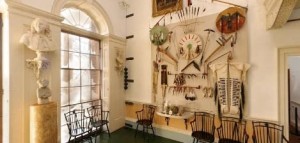
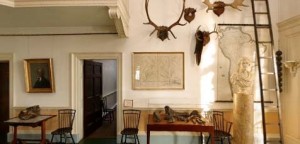
The high ceiling of the Entrance Hall was built to accommodate a very unique feature to the house and one of Jefferson’s inventions. The Great Clock was designed by Jefferson and built to his specifications in Philadelphia in 1793. The large cannonball sized weights and pulley system operate a seven day calendar clock with marks on the south wall that indicate the days of the week, a hole in the floor was made to reach the marks for Friday and Saturday. The Great Clock not only marked time in the house but a Chinese gong on the roof struck on the hour for people working outside the home and a second clock face is on the West Portico of the building.
The Parlor room can be entered directly from the Entrance Hall and there is also access to the room from the West Portico. The Parlor, located in the north wing of the home, is the room where Jefferson socialized and entertained his guests. Just as the Entrance Hall was used by Jefferson to educate his guests, the Parlor was once decorated with thirty-five portraits of the men who influenced American and World history, these great also inspired Jefferson’s values and beliefs. (One can just imagine the interesting discussions that went on in this room between Jefferson and his guests!)
The Dining Room was where Jefferson sat down with his family and guests to eat the two main meals of the day, breakfast and dinner. Two dumbwaiters are installed on either side of the fireplace to bring wine up from the cellar. A unique revolving serving door was another invention by Jefferson to omit the use of wait staff and facilitate a type of self-service meal. The adjacent Tea Room is elegantly decorated with a collection of engraving, portrait miniatures and plaster busts of Franklin, John Paul Jones, Lafayette and Washington.
Two guest bedrooms are located in the north wing at the east front of the house. One special bedroom is known as Mr. Madison’s Room and was used by Jefferson’s close friend James Madison on his frequent visits to Monticello. The room is decorated with distinctive trellis wallpaper; the current reproduction is of a pattern originally purchased by Jefferson in Paris in 1790.
The south wing of the home is located on the other side of the Entrance Hall and at east front are the Family Sitting Room and the Book Room. The Family Sitting Room was used as a private space for Jefferson and his family to gather and relax during the day or in the evenings to play games or music. Adjacent to the Sitting Room is an area known as the Book Room of the house. At one time, this is where Jefferson’s library was located and it held one of the largest personal collections of books in the country. Jefferson was an avid reader and his interests were numerous and varied ranging from subjects such as world history, astronomy, science, natural history, horticulture, philosophy, poetry, classic literature and politics. After the War of 1812, when the British burned Washington D.C. and destroyed the White House and U.S. Capitol building, Jefferson offered his personal collection of books to Congress to replace the ones destroyed. (The sale of Jefferson’s books was a substantial start to the Library of Congress , for more information please click on the link)
Located in the south wing of the home at the west front of the house were Jefferson’s private rooms, his Cabinet and Bedchamber. The Cabinet room was where Jefferson liked to read and answer his many correspondences. In the center of the room Jefferson had a revolving chair and a writing table, the top of the table also revolved. Placed nearby are several of Jefferson’s clever inventions, on the table is a copying machine which Jefferson used to duplicate his numerous letters and next to the table is a revolving book stand that allowed Jefferson to read and reference five books at a time. The room is also filled with several scientific instruments, such as telescopes, microscopes, compasses, thermometers and an astronomical clock that enabled Jefferson to calculate solar and lunar eclipses.
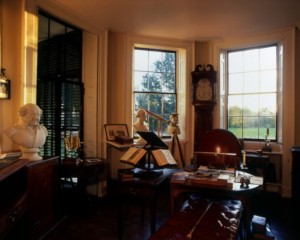
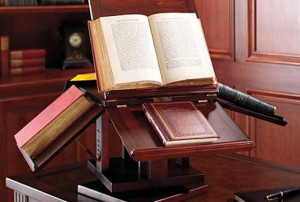
Adjacent to the Cabinet room is Jefferson’s Bedchamber which features an unusual arrangement of Jefferson’s unique double sided bed that is placed in an alcove which allowed him easy access to either the Cabinet or the Bedchamber. Jefferson was an early riser and after waking he would note the time on a black marble obelisk clock located on a shelf at the foot of his bed, he designed the clock’s unique features and had it made in Paris in 1790. Visitors to Monticello always notice and inquire about the purpose of the holes seen in upper portion of the wall. Located in the area above the bed alcove is a closet space that stored some of Jefferson’s clothing and it was accessed by a steep staircase and the openings provided light and ventilation into this area.
Jefferson died in his bed at Monticello on July 4, 1826, he was 82 years old. The date also marked the fiftieth anniversary of the day that the Continental Congress approved the Declaration of Independence, a document that Jefferson is credited for writing, which officially marked the former British colonies freedom from England. On the same day, miles away at his home in Massachusetts, John Adams died five hours later. These two men, friendly adversaries and former Presidents, were the last surviving members of the Continental Congress to have signed the Declaration of Independence.
Travel information for Monticello
(UPDATE: note that the following information was current at the time I wrote this post, for current information and restrictions please consult the Monticello website).
Monticello is open daily year-round and there are several different guided tours and day pass packages available for visitors. For more information on dates and hours of operation as well as tour times and prices, please check the Monticello website at www.monticello.org
- The Monticello Day Pass allows visitors access to the Visitor Center to see the wonderful exhibits and film about Thomas Jefferson as well as the beautifully landscaped grounds of Monticello which include the flower garden and the vineyard, the vegetable garden with the adjacent Mulberry Row where the plantation’s slaves lived and the cemetery were Thomas Jefferson and his family are buried.
- The Basic Tour and Monticello Day Pass Package – The Basic Tour includes the guided tour of the first floor of the house and also included are two additional seasonal guided tours: The first one is the “Slavery at Monticello” tour which is available each weekend in February and daily from April to October. The second one is the “Gardens and Grounds” tour which is available daily from April to October.
- The Behind the Scenes Tour and Monticello Day Pass Package includes everything mentioned in the Basic Tour with the addition of a guided tour of the second floor house, the Dome Room on the third floor and access to a new interactive “Crossroads” exhibit located in the cellar of the house. This is a great tour package for visitors that are interested in information about the unique architectural features of the interior and learning about the current restoration projects at Monticello. For more information on specific dates and times please check the Monticello website at www.monticello.org
- The Family Tour and Monticello Day Pass Package is designed especially for families with children between the ages of 5-11, this package includes a special 40-minute guided tour that is customize for children and their parents. This package is available at limited times during the year: April, June to August, weekends in October and one week in December. For more information on specific dates and times please check the Monticello website at www.monticello.org
The Thomas Jefferson Visitor Center –
After purchasing tickets, I would highly recommend a visit to the Thomas Jefferson Visitor Center either before or after a scheduled house tour, it is a wonderful place to learn about Jefferson’s personal and political life. Currently there are four interesting exhibits that inform visitors about Jefferson’s important legacy and contribution to the United States. The first exhibit is about Jefferson’s values and ideas about liberty, the next exhibit explains the various principles and horticulture techniques that Jefferson developed at Monticello, another exhibit is about the design, architecture and construction of Jefferson’s home, and the final exhibit explores the words and wisdom of Jefferson. Also while visitors are at the Visitor Center they should see the 15-minute film, “Thomas Jefferson’s World”, which explains the importance of Monticello to Jefferson and how it influenced both his personal and political life.
Mulberry Row –
When visiting Monticello, I highly recommend seeing Mulberry Row which is situated to the south of the main house. Mulberry Row was considered the center of Jefferson’s 5,000 acre plantation and it is where the slave quarters were located and the site for the plantation’s vegetable garden and also several outbuildings used as storage houses and for various trades such as blacksmith and joinery.
The vegetable garden was first planted in 1770 but by 1806 Jefferson was making improvements and the 1,000 long terrace supported by a large stone wall was built by the plantation’s slave labor to accommodate the slope of the mountain. In the middle of the garden is a pavilion built for Jefferson’s use in the 1820s and it overlooks an 8-acre orchard of 300 trees and the plantation’s vineyard. The main part of the 2-acre garden grew an abundant variety of produce, such as tomatoes, beans, carrots, lettuce, cabbage, peas and figs, an additional garden plot grew various types of berries such as gooseberries, raspberries. (Travel note: The vegetable garden allows visitors to Monticello a wonderful opportunity to see the beautiful and dramatic views of the Virginia countryside. It is a wonderful place to take photos!)
The Jefferson Family Cemetery –
When Thomas Jefferson died in 1826, his will stipulated his wish to be buried at the family cemetery at Monticello. The large stone obelisk has the inscription, “Here was buried Thomas Jefferson the author of the Declaration of American Independence, of the statute of Virginia for religious freedom and father of the University of Virginia”. The cemetery is still in currently in use as a burial site for Jefferson’s descendants.

